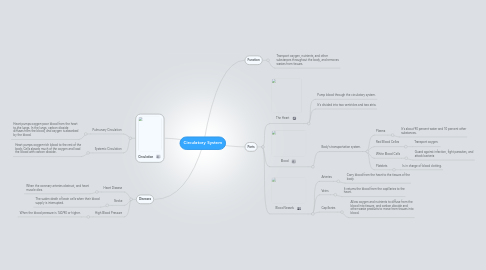
1. Circulation
1.1. Pulmunary Circulation
1.1.1. Heart pumps oxygen-poor blood from the heart to the lungs. In the lungs, carbon dioxide diffuses from the blood, and oxygen is absorbed by the blood.
1.2. Systemic Circulation
1.2.1. Heart pumps oxygen-rich blood to the rest of the body. Cells absorb much of the oxygen and load the blood with carbon dioxide.
2. Diseases
2.1. Heart Disease
2.1.1. When the coronary arteries obstruct, and heart muscle dies.
2.2. Stroke
2.2.1. The suden death of brain cells when their blood supply is interrupted.
2.3. High Blood Pressure
2.3.1. When the blood pressure is 140/90 or higher.
3. Function
3.1. Transport oxygen, nutrients, and other substances throughout the body, and removes wastes from tissues.
4. Parts
4.1. The Heart
4.1.1. Pump blood through the circulatory system.
4.1.2. It's divided into two ventricles and two atria.
4.2. Blood
4.2.1. Body's transportation system.
4.2.1.1. Plasma
4.2.1.1.1. It's about 90 percent water and 10 percent other substances.
4.2.1.2. Red Blood Celles
4.2.1.2.1. Transport oxygen.
4.2.1.3. White Blood Cells
4.2.1.3.1. Guard against infection, fight parasites, and attack bacteria
4.2.1.4. Platelets
4.2.1.4.1. Is in charge of blood clotting.
4.3. Blood Vessels
4.3.1. Arteries
4.3.1.1. Carry blood from the heart to the tissues of the body.
4.3.2. Veins
4.3.2.1. It returns the blood from the capillaries to the heart.
4.3.3. Capillaries
4.3.3.1. Allow oxygen and nutrients to diffuse from the blood into tissues, and carbon dioxide and other waste products to move from tissues into blood.
